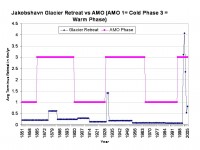By Peter McGurk, Joseph D’Aleo and George Taylor
We received an interesting analysis from Peter McGurk, a meteorologist and climatologist and member of Icecap. It began as follows: “In a NASA posting by Kendall Haven, there was a very interesting discussion entitled “Greenland’s Ice Island Alarm”. The article described how NASA is using advanced satellite technology to try and get an accurate estimate of the amount of ice loss currently occurring in the Greenland Ice Sheet. NASA noted that in terms of ice sheet elevation, most of the loss is occurring near the edges, but due to somewhat warmer temperatures snowfall has increased across interior portions of the ice sheet so that across many inland sections the ice sheet elevations are unchanged or increasing, especially across much of southern Greenland.”
Peter went on to take an in-depth look at the annual retreat rates of the Jakobshavn glacier and their relationship to the AMO (Atlantic Multidecadal Oscillation).

He also finds on the longer time scales interestingly that the interglacial periods seem to be getting shorter while the glacial periods longer. Peter concludes “It seems to me that climate cycles have been occurring on this planet for millions of years and will continue to do so. Latching on to little pieces of these cycles and projecting them out linearly forever is not very realistic. We are still trying to unravel the complexities of our climate system with all its wonderful checks and balances. Maybe someday we might even figure it all out, but as my late professor Dr. Theodore Fujita used to say “nothing integrates as fast as Mother Nature”. In the long run, the Earth will take care of itself and the Greenland ice sheet will be just fine.”
See Peter’s full analysis here. I have added some relevant information supporting Peter’s conclusions from an earlier blog story authored by George Taylor and I.




